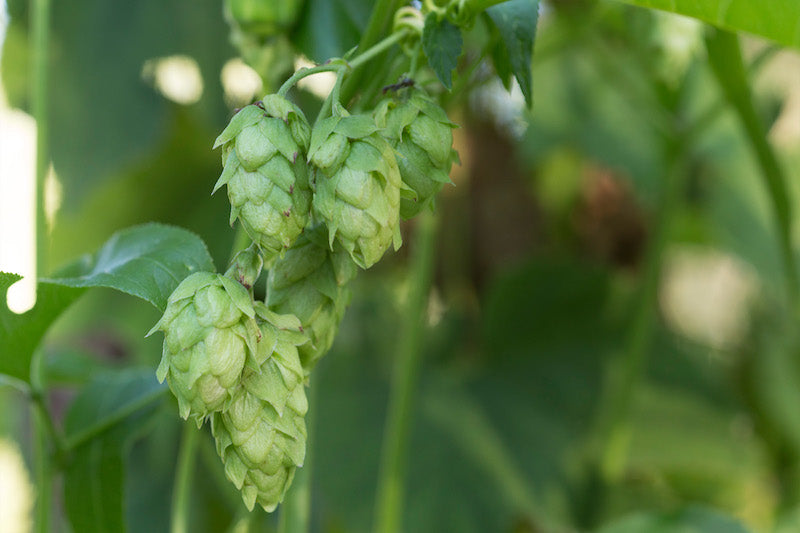You are about to leave the Herb Pharm website. The website will open in a new browser window.
Please select "OK" to continue to the website, or close this box to return to Herb-Pharm.com.

Humulus lupulus
Plant Family
Cannabaceae – Hemp family
Other Names
none
Parts Used
strobile
Uses
Traditional calming support of the nervous system.*
Prominent Phytochemicals
Prominent Constituents as Reported in Scientific Literature: Bitter principles, resins, volatile oils, flavonoids and tannins.4,5
The common name of Hops is derived from the Anglo-Saxon word hoppan, meaning “to climb.”8
Botanical Description
Hops is an herbaceous perennial and dioecious vine that can climb up to 10 meters.3,6,8 Leaves are dark green, cordate and palmately shaped, with deep lobes and a finely toothed margin.4,6,8 Most leaves are positioned oppositely on the stem, but some can be alternately positioned at the vine tips.8 Stems are long, hairy, bendable and hardy, and they yield from a crown.3,4,6,8 The vines intertwine and wind around supports.6,8 Main root is a semi-deep rooted, woody rhizome with an arrangement of underground stems of shallow feeding fibrous root offshoots.3,6 Male flowers are in loose panicles with five bracts and stamens, stemming from the axils.4 Female flowers are pale-green on the leafy cone-shaped catkins.4 Fruits are strobiles covered in overlapping yellow-green bracts.4,8 Seeds are brown achenes, located at the base of the bracts.8
Origins & History
Hops is native to the North temperate zone in the countries of Asia, Europe and North America.4,8 Economically important, this plant is heavily cultivated for its strobiles in those areas.3 In Britain, wild stands can be found in copses and hedges south of York.8
The common name of Hops is derived from the Anglo-Saxon word hoppan, meaning “to climb.”8 The Humulus genus name may originate from the word humus, describing the plant’s soil preference.8 Its species name, lupulus, comes from the Latin lupus, meaning “wolf” in reference to how the plant chokes out Willow trees with its twining vines, similar to a wolf hunting sheep.8
This plant is dioecious, which means its male and female flowers grow on separate plants.6 In cultivation, the male plants are generally not grown.6 This inhibits pollination of the female flowers, which are usually grown by vegetative propagation.6 The part used in herbalism, the female fruit, is a leafy cone called a strobile.8 The bracts of the strobiles are covered in semitransparent glandular trichomes, which exude yellow-orange resins that have the consistency of a coarse powder.4,6,8 The yellow-orange dust on the strobiles, called Hops grains, contain the majority of the plant’s phytochemicals, such as resins.6,8
The habitat preference of the plant is a woodland garden, hedgerow, and north or east wall.3 Hops prefers a dry to moist, humus-rich and loamy soil in sun to semi-shade or no shade with air circulation.3,8 In the first year, the plant has slow growth and starts to bear fruit in the second year, however the third year is said to be at full fruiting potential.8 Flowering happens in July to August, while seeds mature from September to October.3 The plant invites wildlife, including butterflies and caterpillars (for whom it’s a delicacy), but it is wind-pollinated.3 This herb oxidizes rapidly, so it’s best to use strobiles fresh or dry them immediately after harvesting in the fall.3,8
The first recorded use was from Pliny the Elder, a 1st century Roman naturalist, who noted it was common in the garden.8 In those times, the plant’s young spring shoots, leaves and sometimes the succulent rhizome were seen at the market and eaten in salads or blanched.3,8 Nicholas Culpeper, a 17th century English herbalist, botanist, physician and astrologer, stated that Hops is ruled by the planet Mars.7
In mid 1400s England, Henry VI banned the planting of Hops.8 It was still chastised until the reign of Edward VI in the mid 1500s, and it was not grown in amounts comparable to consumption levels until James I in the early 1600s.8 Native Americans widely use Hops in herbalism and food.2 The Algonquin in Quebec, Lakota and Ojibwa tribes use Hops to make bread or use it in place of baking soda, while the Chiricahua and Mescalero Apache use the herb to flavor drinks, wheat flour and potatoes.2 The Navajo use this plant as a charm for good luck when hunting and for protection from witches.2 Other noted tribes that use the plant in herbalism are the Cherokee, Dakota, Delaware, Meskwaki, Mohegan, Round Valley and Shinnecock.2
The stems of the plant have been used as fiber to make coarse cloth and paper.3,8 A brown dye is made from the foliage and cones.8 The perfume industry utilizes an essential oil made from the strobiles.3 Some European body-care products contain the plant extract.3 The preserved vines with fruits can be utilized in dried flower arrangements.3 In folk herbalism, a sachet stuffed with Hops (sometimes combined with Lavender or Mugwort) is commonly placed inside a pillowcase at bedtime.8
Most notably, the female fruit cones known as strobiles, are used in brewing.8 For this use, the ripened cones with immature seeds are ideal for flavor and preservation.3,8 In the early 1300s, Hops were used by the Dutch for ale brewing and later by the Germans in beer.8
References
Don't forget! Check your Rewards account for coupons.
CHECKOUTYou are about to leave the Herb Pharm website. The website will open in a new browser window.
Please select "OK" to continue to the website, or close this box to return to Herb-Pharm.com.